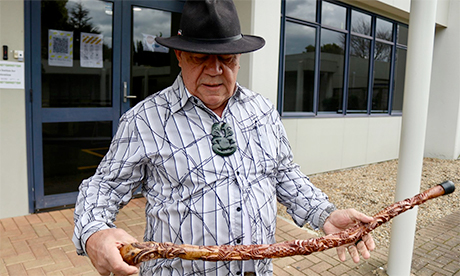A call for help from domestic or family violence is made on average every four minutes in New Zealand, whose high statistics regularly top global lists.
And South Auckland is the country’s ground zero, where 23,000 calls come in yearly for family violence.
The area also has a large Māori and Pacific Islander population, but New Zealand’s police force is mostly white.
Encounters between residents and officers summoned to respond to family disputes have often ended with arrests made and children funnelled into emergency state care, where a bewildering bureaucracy of government agencies and community organizations await.
Families regularly fall through cracks between services that compete for funding.
Often, when help comes, it arrives too late, or doesn’t reflect the culture of perpetrators and victims.
“By the time you blink, you’ve got children living in a virtual war zone, and it’s been a year down the track with five or six more incidents,” said Jonelle McNeil, an operations manager for Barnardos, a New Zealand nonprofit that deals with children and their families impacted by family violence.
Māori are twice as likely to be victims of intimate partner violence compared to all New Zealanders.
Alcohol, poverty and other factors play a role in that.
It is a reflection of the generational trauma facing families whose parents or grandparents moved away from tight-knit, tribal communities to the largely unfulfilled promise of urban jobs.
This is layered over the impact of European colonization that began in the 1800s. (According to scholars who’ve studied the roots of the issue, violence toward a female partner was unacceptable in Māori society before European settlers enforced a gendered belief system.)
But a new Māori-led response to family violence in South Auckland is showing early signs of success in addressing the problem. Te Taanga Manawa — a Māori term meaning a place of rest and safety — was launched in March, bringing together 13 government, Māori and community agencies, including local police, in a single building.
The multi-agency team ensures a collaborative response that is quicker and more culturally nuanced.
As advocates for law enforcement reform in the U.S. wrestle with racial bias in police violence and seek more effective alternatives to traditional policing, New Zealand’s experiment bears watching as a model for how police work and social work can be threaded together.
“It works well because there are no barriers, no bricks and mortar to separate the opportunity to deal with whānau [families] quickly and directly,” said Dee-Ann Wolferstan. She is the chief executive officer of Te Whare Ruruhau o Meri Trust, a social justice arm of the Anglican Church, and Te Iwi o Ngati Kahu Trust, the support service of a Māori tribe.
Both organizations are involved in Te Taanga Manawa.
Te Whare began experimenting with a multiple-agency approach to family violence in 2018 by joining with Barnardos and Fonua Ola, a nonprofit organization that serves Pacific Islander families.
The organizations shared information, brainstormed together, and presented one cohesive strategy to each family.
That meant families had just one point of contact, said Wolferstan, “instead of a million.”
Within 12 months, more than 90% of families referred to the initiative agreed to participate in programs like parenting classes, a jump from 20%.
In South Auckland, local police still respond to the initial incident. But instead of looking at the incident through just a law-and-order lens — make arrests or remove the perpetrator — they seek the root causes of family violence.
“Is this a food issue?” said Wilkie.
“Are there drug and alcohol issues? Have people lost their jobs? Do the children look malnourished?” Continue reading
